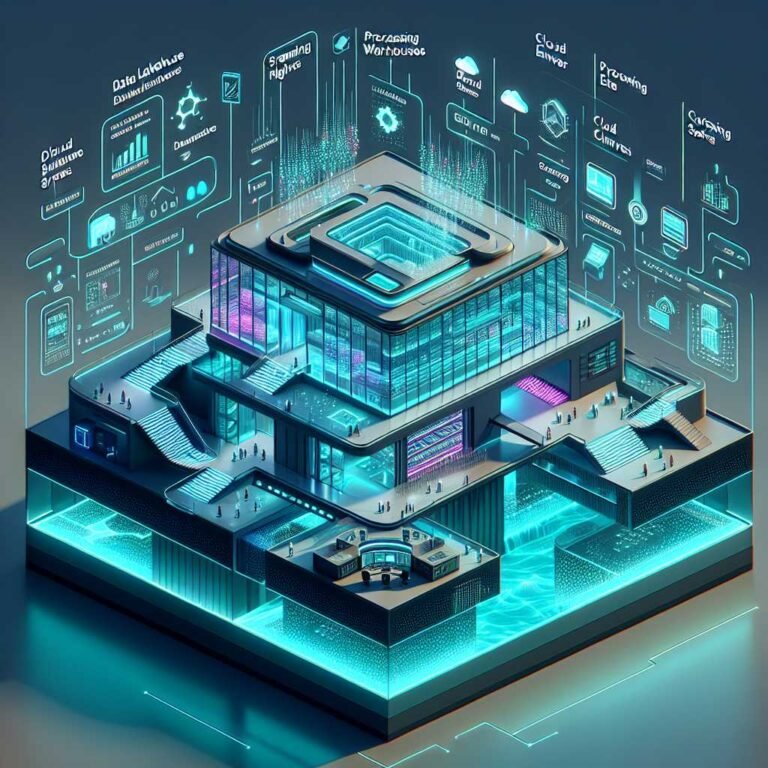Machine Learning on Big Data: How to Do Real-Time Analytics and Forecasting Directly From Live Databases
What if your models could learn and predict from data the moment it lands—without starving your production database or waiting on a nightly batch? That’s the promise of real-time machine learning on big data: analytics and forecasting that run continuously, stay reliable under pressure, and actually improve decision-making in the moment. It sounds complex because it is, but the path gets straightforward once you commit to a few core principles and battle-tested patterns.
I wrote this guide based on real deployments—messy data, flaky pipelines, scaling challenges, and all. My goal is to give you the practical playbook: how to connect safely to live databases, stream data without breaking anything, transform features on the fly, train and serve low-latency models, forecast on fresh inputs, and keep the whole thing observable, debuggable, and cost-aware. Think of this as the blueprint I wish I had before I built a live dashboard that learns, forecasts, and alerts in real time.
What “Real-Time” Really Means (And Why It’s Worth It)
“Real-time” is often used loosely. Let’s be specific. For most analytics and ML systems, real-time means:
- Freshness: New data reflected in dashboards or predictions within seconds to a couple of minutes.
- Latency: End-to-end processing time that fits your use case (sub-100 ms for online inference; sub-5 seconds for streaming analytics is common).
- Throughput: Sustained processing of events at or above your peak traffic.
- Reliability: Predictable behavior under load, graceful degradation, and no impact on your source-of-truth database.
Here’s why that matters: when your organization trusts that your forecasts are timely and stable, they’ll use them to automate real decisions—pricing, inventory, fraud screening, capacity planning, and more. The key is to define service-level objectives (SLOs): how fresh is fresh enough, what is acceptable latency, and what error budget you can tolerate. This prevents scope creep and guides architecture choices.
The Production-Ready Architecture for Live ML
At a high level, your real-time ML stack will look like this:
- Source-of-truth database: PostgreSQL, MySQL, SQL Server, Snowflake, BigQuery, etc.
- Safe data access: read-replicas, Change Data Capture (CDC), or event streams.
- Durable transport: a log like Apache Kafka or a managed equivalent.
- Stream processing: engines such as Apache Flink or Spark Structured Streaming.
- Feature transformation: windowed aggregations, joins, normalization, and PII handling.
- Model training and serving: offline training plus online inference endpoints; feature store integration (e.g., Feast).
- Monitoring and observability: metrics, logs, traces, and data-quality checks.
- Governance and security: access control, encryption, and audit.
The trick is coordinating these parts so they’re robust and cost-effective. You’ll start by decoupling your production database from your ML workload—never slam prod with heavy queries—and flowing changes through a reliable stream to your processing and serving layers. If you’re ready to upgrade with a complete step-by-step blueprint, Buy on Amazon.
Secure, Read-Only Connections to Live Databases
Rule one: never write to your production transactional database from your analytics or ML stack. And limit reads. You have three safe patterns:
- Read replicas: A replicated database instance dedicated to extracts. Keep an eye on replication lag and set query timeouts.
- CDC (Change Data Capture): Stream row-level changes (inserts/updates/deletes) via logical replication or connectors like Debezium. This is often the most scalable.
- Event sourcing: Emit domain events from your application directly to a log; treat the DB as one consumer.
Security and reliability checklist: – Use least privilege with role-based access control (RBAC) and network policies (security groups, VPC peering, IP allowlists). NIST Zero Trust provides guiding principles. – Enforce TLS in transit and encrypt at rest. – Implement connection pooling and backoff to avoid overwhelming replicas. – Cap query complexity; always paginate or window large extracts.
If your org follows the OWASP ASVS, mapping your data access patterns to its controls will keep auditors happy and production safe.
CDC, Schema Evolution, and the Outbox Pattern
CDC lets you ingest changes as they happen—perfect for real-time signals. But there are pitfalls:
- Schema evolution: When columns are added, removed, or re-typed, downstream jobs must adapt. Use a schema registry, JSON with versioned payloads, or Protobuf/Avro with compatibility rules.
- Idempotency: Deliveries can repeat; make your sinks idempotent (use primary keys, deduplication, or upserts).
- Ordering: Per-key ordering matters. Partition streams by entity (e.g., customer_id) to preserve order.
- The outbox pattern: Instead of mining CDC from many tables, have the app write domain events to an outbox table, which CDC then streams. Cleaner and less leaky.
In practice, you’ll backfill history once to prime your features, then switch to CDC for continuous updates. For a hands-on walkthrough with code and diagrams across these patterns, Check it on Amazon.
Building Stream-First Feature Pipelines
Good features beat clever models. In real time, feature engineering shifts from batch jobs to streaming transformations:
- Deduplication and late data: Use watermarks and windows so late-arriving events still count without reprocessing everything.
- Sliding and tumbling windows: Compute counts, sums, and rates over the last N minutes/hours. Think “orders in the last 30 minutes” or “avg error rate by service in the past 5 minutes.”
- Dimensional joins: Enrich events with reference data (customer tier, product category) from a cache or feature store.
- Normalization: Standardize text, handle categorical encodings, and ensure units are consistent.
- PII handling: Plumb redaction or tokenization for sensitive fields before events leave the trust boundary.
A feature store helps guarantee your online inference features match the offline training features. Mismatched semantics are a silent killer of accuracy. The tighter the contract between offline and online transforms, the less drift you’ll fight later.
Training Models That Serve in Milliseconds
A model that scores at 5 ms beats a fancy one that needs 500 ms and a GPU. Pick the simplest model that hits your business metric within your latency budget.
Practical tips: – Start with linear models or tree-based methods (logistic regression, XGBoost, LightGBM). They’re fast, interpretable, and strong baselines. – Precompute heavy features in the stream; keep inference cheap. – Cache features and/or predictions when possible (e.g., per-user session). – If you need deep learning, consider distillation, quantization, or ONNX export to slim models for CPU inference.
Establish a champion-challenger loop: – Champion model serves traffic. – Challenger trains on the same stream and get shadow traffic or a percentage split. – Promote only when challenger beats champion on a holdout metric and operational SLOs.
Track both model metrics (AUC, RMSE) and business metrics (conversion, revenue lift), and alert on regressions. If you want techniques and templates that minimize modeling friction in production, Shop on Amazon.
Streaming Forecasts and Real-Time Anomaly Detection
Forecasting in real time is different from forecasting offline once a day. You need stateful models that update as new data arrives and can answer “what’s next?” in seconds.
Patterns that work: – Incremental models: Use algorithms that support partial_fit or state updates; maintain rolling windows for ARIMA-like signals or use state space models. – Hierarchical forecasting: If you forecast by product, region, and store, maintain aggregates at each level; reconcile to keep totals consistent. – Seasonality and events: Encode known events (holidays, releases) and weekly seasonality with engineered features; persist seasonal profiles in a fast store. – Anomaly detection: Pair your forecast with quantile or prediction intervals; alert when observations leave bounds. For time series with concept drift, methods like EWMA baselines or streaming isolation forests can catch sudden changes.
A rule of thumb: alert on sustained deviations rather than single spikes. Use suppression windows to reduce noise. Humans will trust your system more if you avoid alert fatigue.
Scaling, Backpressure, and Exactly-Once (The Truth)
There’s a reason practitioners roll their eyes at “exactly-once” claims. True exactly-once across distributed systems is incredibly hard; what you want is effectively-once behavior for your business logic.
Guidelines: – Prefer at-least-once delivery with idempotent writes. Design sinks to handle duplicates and retries. – Use transactions and atomic upserts where possible. Leverage message keys and sequence numbers. – Checkpoint state in your stream processor and keep replayable logs. This allows fast recovery and backfills. – Monitor consumer lag to catch backpressure early; autoscale consumers and workers based on lag and CPU.
To dive deeper into semantics and guarantees, read the Confluent explanation of exactly-once semantics in Kafka. The bottom line: reliability is a design, not a checkbox.
Choosing Your Stack: Tools, Specs, and Buying Tips
There’s no one “right” stack, but your choices should map to your SLOs, team skills, and budget.
Popular building blocks: – Data movement: Kafka or cloud equivalents (Pub/Sub, Kinesis), plus Debezium for CDC. – Stream compute: Flink for low-latency stateful processing; Spark Structured Streaming for teams already on Spark; cloud-native engines if you prefer managed. – Storage: Object storage for history, columnar warehouses for analytics, and a low-latency store (Redis, DynamoDB, Bigtable) for online features. – Serving: A lightweight REST/gRPC service (FastAPI, BentoML) with autoscaling. – Observability: Prometheus and Grafana for metrics and dashboards; request tracing if you have multiple hops.
Hardware and spec considerations: – Memory is king for stateful streaming; size state + headroom. – NVMe SSDs help with checkpoint and local state performance. – CPUs with strong single-thread performance benefit low-latency inference. – GPUs only when deep models truly justify them; otherwise they add complexity and cost. – Network throughput and egress costs matter at scale—budget for them.
When you’re comparing tools and specs for a real-time ML build, See price on Amazon.
Monitoring, Quality, and Drift: What to Watch
A healthy real-time ML system is measured, not assumed. Instrument early.
Measure four dimensions: – System health: CPU, memory, consumer lag, throughput, error rates, retries. – Data quality: Schema conformity, null rates, range checks, unique keys, drift in distributions. Tools like Great Expectations can help validate assumptions. – Model performance: Online metrics (AUC, log loss, MAE), calibration, and slice performance by segment (region, device, customer tier). – Business outcomes: Uplift against control, revenue impact, cost-to-serve.
Alerting strategy: – SLO-based alerts with error budgets (e.g., 99% of inferences under 50 ms over 30 days). – Multi-signal alerts to avoid flapping (e.g., combine elevated error rate + rising consumer lag). – Clear runbooks and automatic remediation where safe (restart a consumer, add replicas).
For operational discipline, the Google SRE book is gold. It maps the mindset you need to keep real-time systems boring—in the best way.
Reliability Patterns: Failing Safely
Nothing runs perfectly. Your job is to fail predictably:
- Circuit breakers: If a downstream service is struggling, shed load to keep the rest healthy.
- Dead-letter queues: Capture poison messages for review without wedging the pipeline.
- Timeouts and retries with jitter: Avoid thundering herds and long tail latencies.
- Fallbacks: If real-time features are unavailable, serve a cached prediction or a simpler baseline.
- Rollouts: Use canaries and feature flags for new models or transformations; roll back fast on regressions.
These patterns keep user impact low and buy you time to fix issues without a 3 a.m. incident call.
Case Study: The Live Forecasting Dashboard
Let me make this concrete. In my own production dashboard:
- Source: A Postgres OLTP database publishes CDC via Debezium to Kafka.
- Processing: Flink jobs compute sliding-window features (e.g., recent conversions by campaign) and maintain stateful counts with watermarks to handle late events.
- Features: A small online store (Redis) serves fresh features to the model API with millisecond access.
- Modeling: A champion-challenger pair of gradient-boosted models serve with FastAPI; we precompute heavy aggregates to keep inference under 10 ms p95.
- Forecasts: State space models produce next-60-minute projections per entity, with quantile bands to drive alerting rules.
- Monitoring: Prometheus and Grafana track system and model KPIs; Great Expectations checks schema and value ranges on the stream.
- SLOs: 99% of inferences under 50 ms; end-to-end event-to-dashboard under 5 seconds; <0.1% message loss with idempotent sinks.
It’s not flashy, but it’s robust: the dashboard updates in seconds, forecasts stay calibrated, and on-call is quiet. To see the full blueprint, design decisions, and performance benchmarks, View on Amazon.
Governance, Privacy, and Compliance (Without Slowing Down)
Real-time doesn’t excuse you from compliance; it makes governance more important.
- Data minimization: Don’t stream what you don’t need. Remove PII early and tokenize where possible.
- Access control: Separate duties; log and audit every access; rotate credentials.
- Retention: Keep only as long as necessary for the business and legal requirements.
- Explainability: Maintain model cards and feature documentation; track versions for reproducibility.
- Regional boundaries: Keep data in-region if laws require it; anonymize cross-region aggregates.
These guardrails keep your velocity high and your risk low.
From Prototype to Production: A Rollout Game Plan
You don’t need to “boil the ocean.” Ship value steadily:
- Define SLOs and the one metric that matters (e.g., fraud capture at 50 ms p95).
- Start with a read-replica or single CDC stream and a simple model baseline.
- Add observability from day one.
- Move feature engineering into the stream; shorten batch training loops.
- Introduce a feature store to unify online/offline features.
- Adopt champion-challenger; test with shadow traffic.
- Harden with retries, DLQs, and circuit breakers.
- Iterate on cost: autoscale, compress payloads, and right-size instances.
You’ll earn trust by being predictable and transparent about performance and impact.
Common Pitfalls (And How to Avoid Them)
- Overcomplicating the stack: Choose fewer, well-understood tools. Complexity taxes every incident.
- Ignoring data contracts: Agree on schemas and semantics with producers; publish changes before you deploy them. See this perspective on contracts and ownership in Martin Fowler’s discussion of data mesh.
- Mismatched features: Ensure training and serving compute features the same way; test parity regularly.
- Underestimating ops: Your ML system is a software system; invest in SRE practices, alerting, and runbooks.
- Skipping backfills: You need a consistent historical baseline before switching on real-time updates.
If you avoid these traps, you’ll ship faster and sleep better.
FAQ: Real Questions People Ask
Q: How do I connect to a live database without impacting production? A: Use a read-replica or CDC via a connector like Debezium. Limit access with least-privilege roles, set query timeouts, and apply connection pooling. Avoid full-table scans; prefer incremental reads.
Q: What latency counts as “real-time” for ML? A: It depends on the use case. Online personalization often needs sub-100 ms inference; dashboards and alerts are fine with 1–10 seconds end-to-end. Define SLOs up front so your team can make smart trade-offs.
Q: What models work best for low-latency inference? A: Start with simple, strong baselines like logistic regression, linear models, or gradient-boosted trees. They’re fast, stable, and often good enough. Reserve deep learning for cases where it clearly pays off—and optimize with quantization or distillation.
Q: How do I handle schema changes without breaking the pipeline? A: Version your schemas, use a registry, and enforce compatibility rules. Add fields in a backward-compatible way, and deploy consumers that ignore unknown fields until they’re ready to use them.
Q: How do I detect model drift in real time? A: Monitor feature distributions and target outcomes; compare to training baselines. Use population stability indices or simple KS tests over sliding windows, and alert on sustained deviation. Retrain regularly and validate challenger models before promotion.
Q: Should I build my own stream processor or use managed services? A: If your team is small or new to streaming, start managed to reduce operational load. You can move to self-managed once you understand your steady-state requirements and cost profile.
Q: How do I do real-time forecasting on irregular event streams? A: Aggregate events into time buckets (e.g., 1-minute windows) with watermarks; maintain rolling features; use stateful models that update incrementally. Forecast on the aggregated series, not on the raw event firehose.
The Bottom Line
Real-time machine learning on big data is doable, repeatable, and worth it when you follow a pragmatic blueprint: protect your database, stream your changes, keep features consistent, choose fast models, and instrument everything. Start simple, ship value quickly, and invest in reliability so your forecasts and decisions can run 24/7 without drama. If you found this useful, keep exploring our guides and consider subscribing for deep dives, case studies, and templates you can put to work this week.
Discover more at InnoVirtuoso.com
I would love some feedback on my writing so if you have any, please don’t hesitate to leave a comment around here or in any platforms that is convenient for you.
For more on tech and other topics, explore InnoVirtuoso.com anytime. Subscribe to my newsletter and join our growing community—we’ll create something magical together. I promise, it’ll never be boring!
Stay updated with the latest news—subscribe to our newsletter today!
Thank you all—wishing you an amazing day ahead!
Read more related Articles at InnoVirtuoso
- How to Completely Turn Off Google AI on Your Android Phone
- The Best AI Jokes of the Month: February Edition
- Introducing SpoofDPI: Bypassing Deep Packet Inspection
- Getting Started with shadps4: Your Guide to the PlayStation 4 Emulator
- Sophos Pricing in 2025: A Guide to Intercept X Endpoint Protection
- The Essential Requirements for Augmented Reality: A Comprehensive Guide
- Harvard: A Legacy of Achievements and a Path Towards the Future
- Unlocking the Secrets of Prompt Engineering: 5 Must-Read Books That Will Revolutionize You







